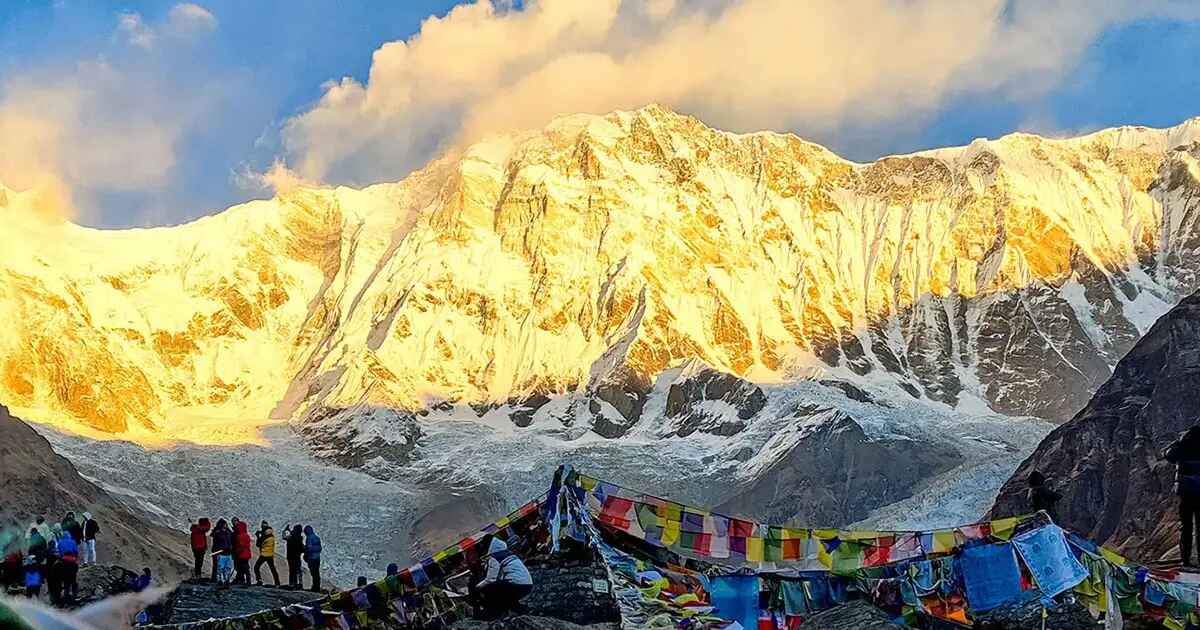Trekking to Annapurna Base Camp is a captivating journey that draws adventurers from around the world to the heart of the Himalayas. For beginners, this trek offers a unique blend of challenge and beauty, making it an ideal introduction to high-altitude trekking. Nestled in Nepal’s Annapurna Conservation Area, the route to the base camp provides an immersive experience of diverse landscapes, rich cultural encounters, and stunning natural vistas.
Starting from the bustling city of Pokhara, trekkers are soon enveloped by the tranquil atmosphere of the foothills. The trek typically begins with a gentle ascent through lush forests, where the air is filled with the soothing sounds of local wildlife and the rustling of leaves. As the trail progresses, the scenery transforms dramatically. Dense woods give way to terraced fields and quaint villages, each offering a glimpse into the traditional lives of the Gurung and Magar communities. These interactions enrich the trekking experience, as trekkers have the opportunity to learn about local customs, sample traditional cuisine, and witness the warm hospitality of the mountain people.
The journey to Annapurna Base Camp is well-paced, allowing beginners to acclimatize gradually to the increasing altitude. The trail’s gradual ascent is designed to maximize enjoyment and minimize the risk of altitude sickness. As trekkers move higher, the landscape opens up to reveal breathtaking panoramas of snow-capped peaks and towering mountains. The Annapurna Massif, with its majestic summits and sweeping glaciers, dominates the skyline, providing a dramatic backdrop to the trek. Each day brings a new chapter of stunning vistas, from the verdant valleys of the lower regions to the rugged terrain near the base camp.
One of the most rewarding aspects of the trek is the sense of accomplishment felt upon reaching Annapurna Base Camp itself. At an elevation of 4,130 meters, the base camp offers an unparalleled vantage point from which to marvel at the surrounding peaks, including Annapurna South, Annapurna I, and Machapuchare, the iconic “Fishtail” Mountain. The panoramic views from the base camp are nothing short of awe-inspiring, providing a profound sense of connection to the natural world and a deeper appreciation for the power and beauty of the Himalayas.
Safety and comfort are prioritized throughout the trek, with well-established lodges and guesthouses providing accommodation along the route. These lodgings offer a cozy respite after a day of trekking, complete with hearty meals and the opportunity to interact with fellow travelers. The journey is not just a physical challenge but also a chance for personal growth and self-discovery, as trekkers push their boundaries and embrace the serenity of the high mountains.
In summary, the trek to Annapurna Base Camp is a remarkable adventure that combines natural beauty, cultural immersion, and personal achievement. For beginners, it represents an accessible yet rewarding trek that promises unforgettable memories and a profound sense of connection to the majestic Himalayas.
Introduction to Annapurna Base Camp Trek
The Annapurna Base Camp (ABC) trek is a premier trekking experience in Nepal’s Himalayas, renowned for its stunning landscapes and cultural richness. This trek offers a unique opportunity to witness the breathtaking grandeur of the Annapurna Massif, which includes some of the world’s highest peaks, such as Annapurna I and Machapuchare. Starting from the picturesque city of Pokhara, the journey leads through diverse terrains, from lush forests and terraced fields to alpine meadows and rocky outcrops. As trekkers advance, they experience a gradual ascent that reveals increasingly dramatic views of snow-capped mountains, including the towering Annapurna range. The trek not only showcases the natural beauty of the region but also provides a deep immersion into the local culture and traditions of the Gurung and Magar communities. The Annapurna Base Camp itself, situated at an altitude of 4,130 meters, offers an unparalleled panoramic view of the surrounding peaks, creating a memorable climax to the trek. For many, this trek is more than just a physical challenge; it is a journey of personal growth and self-discovery set against one of the most awe-inspiring backdrops on Earth.
Why Choose Annapurna Base Camp?
The Annapurna Base Camp trek is a compelling choice for trekkers seeking a combination of natural beauty, cultural experiences, and a manageable challenge. Unlike more demanding treks, the ABC trek is relatively accessible, making it ideal for beginners and seasoned trekkers alike. The route offers an impressive variety of landscapes, from subtropical forests and terraced fields to high-altitude meadows and glacial moraines. The gradual ascent allows trekkers to acclimate properly, minimizing the risk of altitude sickness while still providing a genuine high-altitude experience. Additionally, the trek passes through charming mountain villages, where trekkers can engage with local communities and experience their traditional way of life. The sense of accomplishment upon reaching Annapurna Base Camp, surrounded by towering peaks and panoramic vistas, is unparalleled. This trek also benefits from well-established infrastructure, including comfortable lodges and knowledgeable guides, which enhances the overall trekking experience. For those seeking a trek that combines stunning scenery with cultural richness and moderate difficulty, the Annapurna Base Camp trek stands out as an excellent choice.
Essential Gear and Equipment
Preparing for the Annapurna Base Camp trek requires careful selection of gear and equipment to ensure safety, comfort, and enjoyment throughout the journey. Essential items include a high-quality trekking backpack, sturdy trekking boots with good ankle support, and moisture-wicking clothing layers. A lightweight down jacket and thermal base layers are crucial for warmth in the higher altitudes, where temperatures can drop significantly. Rain gear, such as a waterproof jacket and pants, is also important, given the possibility of rain or snow. Trekking poles can provide stability and reduce strain on the knees during ascents and descents. Adequate sun protection, including sunglasses with UV protection and a wide-brimmed hat, is essential to shield against intense sunlight. Additionally, a good sleeping bag rated for cold temperatures and a personal first-aid kit are recommended. Hydration and nutrition are key, so carrying a water bottle or hydration system and energy-boosting snacks is beneficial. Lastly, a reliable camera or smartphone to capture the stunning landscapes and moments along the trek will ensure that memories are preserved. Properly equipping yourself with these essentials will enhance your trekking experience and help you tackle the challenges of the Annapurna Base Camp trek with confidence.
Best Time to Trek
Choosing the best time to trek to Annapurna Base Camp is crucial for experiencing optimal weather conditions and enjoying the trek to its fullest. The ideal trekking seasons are pre-monsoon spring (March to May) and post-monsoon autumn (September to November). During these periods, the weather is generally stable, with clear skies and minimal chance of heavy rainfall or snow, which provides excellent visibility of the surrounding peaks and comfortable trekking conditions. Spring offers mild temperatures and blooming rhododendron forests, adding a splash of color to the journey. Autumn is characterized by crisp air and clear skies, ideal for panoramic views of the Annapurna Massif. Winter (December to February) and monsoon season (June to August) present their own challenges. Winter trekking is possible but comes with colder temperatures and higher risks of snow and ice, which can make the trails more difficult and less accessible. Monsoon season brings heavy rains, leading to slippery trails and increased risk of landslides, which can hinder trekking plans. Planning your trek during the peak seasons ensures the best chance of favorable weather, allowing for a more enjoyable and memorable experience.
Preparing for the Trek: Physical Fitness and Training
Preparing for the Annapurna Base Camp trek involves physical fitness and training to ensure that you can handle the trek’s demands and enjoy the journey. The trek, while accessible to beginners, requires a reasonable level of fitness due to its moderate to challenging terrain and altitude. A well-rounded fitness regimen should focus on cardiovascular endurance, strength, and flexibility. Cardiovascular exercises such as running, cycling, or hiking on inclines help build stamina and prepare your heart and lungs for the trek. Strength training, particularly for the legs and core, is crucial for navigating the uneven and sometimes steep terrain. Exercises such as squats, lunges, and step-ups can enhance leg strength and stability. Additionally, incorporating exercises that improve balance and flexibility, such as yoga, can help with trekking over rocky paths and uneven surfaces. It’s also beneficial to undertake practice hikes with a loaded backpack to simulate trek conditions and get accustomed to carrying weight. Gradual increases in the distance and elevation of your practice hikes can help you build endurance and acclimate to the physical demands of the trek. Consistent training leading up to the trek will not only enhance your physical preparedness but also boost your confidence and overall trekking experience.
Permits and Regulations
Embarking on the Annapurna Base Camp trek requires obtaining specific permits and adhering to local regulations to ensure a smooth and legal trekking experience. The primary permits required are the Annapurna Conservation Area Permit (ACAP) and the Trekkers’ Information Management System (TIMS) card. The ACAP is essential for trekking within the Annapurna Conservation Area and helps fund conservation efforts and local development projects. The TIMS card, issued by the Nepal Tourism Board or a recognized trekking agency, helps monitor and manage trekkers’ safety and well-being. These permits can be obtained in Pokhara or Kathmandu, but it’s advisable to arrange them through a local trekking agency for convenience and to ensure all paperwork is in order. Additionally, trekkers should be aware of local regulations and guidelines to minimize their impact on the environment and respect local customs. This includes following designated trails, minimizing waste, and supporting local communities by purchasing goods and services from local vendors. Adhering to these regulations not only ensures a hassle-free trekking experience but also contributes to the preservation of the natural and cultural heritage of the Annapurna region.
Day-by-Day Itinerary Overview
The ABC trek typically spans 7 to 12 days, depending on the chosen itinerary and pace. The journey begins with a drive or flight from Kathmandu to Pokhara, followed by the start of the trek from Nayapul or Kimche. The first few days involve trekking through lush forests, terraced fields, and traditional villages. The itinerary generally includes stops at Ghorepani, known for its panoramic sunrise views over the Annapurna and Dhaulagiri ranges, and Tadapani, which offers a mix of stunning vistas and local culture. The trek continues through diverse landscapes, including bamboo forests and alpine meadows, as trekkers make their way to the base camp. The highlight of the trek is reaching Annapurna Base Camp, situated at 4,130 meters, where trekkers are rewarded with breathtaking views of the Annapurna Massif. The return journey usually follows a similar route, allowing for further exploration and acclimatization. The itinerary may also include rest days or acclimatization hikes, particularly if trekkers are sensitive to altitude. Overall, the day-by-day progression of the trek is designed to balance challenging ascents with periods of rest and recovery, ensuring a rewarding and manageable trekking experience.
Accommodations and Lodging
Accommodations along the Annapurna Base Camp trek are primarily provided in lodges and guesthouses, offering trekkers a range of options for comfort and convenience. These lodgings are typically simple but comfortable, with rooms equipped with basic amenities such as beds, blankets, and sometimes electricity. The higher the altitude, the more basic the accommodations become, but they generally provide a warm and welcoming environment after a day of trekking. In lower-altitude areas, such as Pokhara and villages like Nayapul and Ghorepani, lodges offer additional comforts, including private rooms and en-suite facilities. As the trek ascends, particularly towards the higher regions near Annapurna Base Camp, accommodations become more basic with shared facilities. Meals are typically provided in the lodges, offering a range of local and international dishes, including dal bhat (a traditional Nepalese meal), soups, and pasta. While accommodations are generally sufficient for the needs of trekkers, it’s important to manage expectations and be prepared for more basic conditions in higher elevations. Staying in these lodges also provides opportunities for cultural interactions with local families and fellow trekkers, adding to the overall experience of the trek.
Safety Tips and Health Precautions
Ensuring safety and maintaining health are paramount on the Annapurna Base Camp trek due to the challenges of high-altitude trekking and remote environments. To minimize risks, it’s essential to acclimatize properly by ascending gradually and allowing time for rest. Symptoms of altitude sickness, such as headaches, nausea, and dizziness, should be taken seriously, and it’s crucial to descend if symptoms persist. Carrying a basic first-aid kit, including medications for altitude sickness, is advisable. Staying hydrated by drinking plenty of water helps prevent altitude-related issues and keeps energy levels up. Regular handwashing and using hand sanitizers can reduce the risk of gastrointestinal illnesses. It’s also important to wear appropriate clothing layers to regulate body temperature and protect against weather conditions, which can change rapidly. Trekking with a reputable guide or agency enhances safety, as experienced guides are trained to handle emergencies and provide support throughout the trek. Additionally, maintaining communication with fellow trekkers and following local regulations contributes to a safe trekking environment. By adhering to these safety tips and health precautions, trekkers can ensure a safe and enjoyable experience on their journey to Annapurna Base Camp.
Navigating the Trail: What to Expect
Navigating the trail to Annapurna Base Camp offers trekkers a dynamic and ever-changing experience, with each day presenting new challenges and rewards. The trek begins with a gradual ascent through lush, subtropical forests, where the trail is well-marked and relatively easy to follow. As trekkers progress, the landscape transitions to terraced fields and charming mountain villages, providing opportunities to interact with local communities and experience their way of life. The trail becomes steeper and more rugged as it ascends through bamboo and rhododendron forests, with sections that may be muddy or uneven, particularly during or after rain. Trekking conditions can vary from day to day, with some paths winding along rivers and others climbing steadily through higher altitudes. The approach to Annapurna Base Camp involves crossing several high-altitude meadows and rocky terrain, where the trail becomes more exposed to the elements. Navigation is generally straightforward, but trekkers should be prepared for varying weather conditions and possible snowfall at higher elevations. Following established trails and paying attention to trail markers will help ensure safe and accurate navigation. Overall, the trail to Annapurna Base Camp offers a rewarding journey through diverse landscapes, culminating in a spectacular arrival at the base camp surrounded by towering peaks.
Cultural Experiences and Local Communities
One of the highlights of the Annapurna Base Camp trek is the opportunity to engage with the local communities and immerse oneself in the rich cultural heritage of the Annapurna region. The trek passes through several traditional villages, including those inhabited by the Gurung and Magar communities, each with its own unique customs and traditions. Visitors often have the chance to interact with local families, learn about their daily lives, and experience traditional practices such as farming, weaving, and cooking. Cultural experiences may include participating in local festivals, attending religious ceremonies at village monasteries, and enjoying traditional Nepali meals. The warmth and hospitality of the local people add a personal touch to the trekking experience, providing insights into their way of life and fostering a deeper connection with the region. Trekkers can also explore local handicrafts and souvenirs, supporting local artisans and contributing to the local economy. These cultural interactions not only enrich the trekking experience but also foster mutual understanding and appreciation between trekkers and the communities they visit, creating lasting memories and meaningful connections.
Weather Conditions and What to Pack
Weather conditions on the Annapurna Base Camp trek can vary significantly depending on the season, altitude, and time of day. In general, the best trekking seasons are spring (March to May) and autumn (September to November), when the weather is relatively stable with clear skies and moderate temperatures. However, temperatures can drop sharply at higher altitudes, especially during the night, so packing appropriately is crucial. Essential items to pack include a moisture-wicking base layer, an insulating mid-layer such as a fleece or down jacket, and a waterproof outer layer to protect against rain or snow. Trekking pants, thermal socks, and sturdy, water-resistant boots are also important for comfort and protection. Accessories such as a warm hat, gloves, and sunglasses are necessary for protection against cold and sun exposure. A lightweight, durable backpack should carry personal items, including a sleeping bag rated for cold temperatures and a water bottle or hydration system. Packing for varying weather conditions, including potential snowfall or rain, ensures that trekkers stay comfortable and prepared throughout the trek. Checking weather forecasts before departure and making necessary adjustments to packing lists can further enhance the trekking experience.
Dealing with Altitude Sickness
Altitude sickness, or acute mountain sickness (AMS), is a common concern on high-altitude treks like the ABC weather journey. It occurs when the body struggles to adjust to reduced oxygen levels at higher elevations. Symptoms can range from mild, such as headaches, nausea, and dizziness, to severe, including difficulty breathing and loss of consciousness. To minimize the risk of altitude sickness, it’s crucial to acclimatize properly by ascending gradually and allowing time for rest. Following a “climb high, sleep low” strategy, where trekkers spend time at higher altitudes during the day but sleep at lower elevations, can aid in acclimatization. Staying hydrated, eating well-balanced meals, and avoiding alcohol and smoking also help the body adjust. If symptoms of altitude sickness develop, it’s important to act quickly by resting, staying hydrated, and descending to a lower altitude if necessary. Medication, such as acetazolamide, can be used to alleviate symptoms, but it should be taken under medical guidance. Trekking with a knowledgeable guide or agency enhances safety, as they are trained to recognize and manage altitude sickness and provide appropriate care. By taking these precautions, trekkers can reduce the risk of altitude sickness and ensure a safer and more enjoyable trek.
Food and Nutrition on the Trek
Food and nutrition play a significant role in maintaining energy and health during the Annapurna Base Camp trek. Meals are typically provided at lodges along the trail and include a variety of local and international options. Traditional Nepali meals, such as dal bhat (rice with lentil soup) and momo (dumplings), are commonly served and provide essential carbohydrates, proteins, and nutrients. As trekkers ascend to higher altitudes, menu options may become more limited, with a focus on calorie-dense foods that provide sustained energy. It’s important to maintain a balanced diet by incorporating a mix of carbohydrates, proteins, and fats, and staying hydrated with plenty of water. Bringing some high-energy snacks, such as nuts, granola bars, and dried fruit, can be beneficial for quick energy boosts between meals. While most lodges cater to trekkers’ dietary preferences, those with specific dietary restrictions or allergies should communicate their needs in advance to ensure suitable options are available. Eating well and staying nourished helps trekkers cope with the physical demands of the trek and enhances overall enjoyment. Maintaining good nutrition and hydration throughout the journey is essential for sustaining energy levels and achieving a successful trek to Annapurna Base Camp.
Post-Trek Reflections and Celebrations
Reaching Annapurna Base Camp is a remarkable achievement and provides a perfect opportunity for post-trek reflections and celebrations. After the challenging journey through diverse landscapes and varying altitudes, arriving at the base camp and soaking in the panoramic views of the Annapurna Massif offers a profound sense of accomplishment. Trekkers often take time to reflect on their personal journey, the experiences encountered along the trail, and the physical and emotional growth achieved. Celebrations may include gathering with fellow trekkers and guides to share stories, enjoy a celebratory meal, and commemorate the successful completion of the trek. Many trekkers also take the opportunity to visit Pokhara or Kathmandu after the trek to relax and explore the cultural and natural attractions of these vibrant cities. Reflecting on the trek provides a chance to appreciate the beauty of the Himalayas, the challenges overcome, and the connections made with local communities and fellow travelers. The post-trek period is also a time to share experiences with friends and family, relive memories through photographs, and plan future adventures. Overall, the conclusion of the ABC Trek overview is a moment of celebration and reflection, marking the end of an unforgettable journey and the beginning of cherished memories
Conclusion
The Annapurna Base Camp trek is a remarkable journey that seamlessly blends adventure with cultural immersion and natural splendor. As trekkers explore this renowned route, they encounter a range of experiences that contribute to an unforgettable adventure. From the initial preparation and understanding of the trek’s appeal to the detailed planning required for gear, permits, and acclimatization, each element plays a crucial role in ensuring a successful trek.
Selecting the best time to trek and adhering to safety guidelines are essential for navigating the challenges of high-altitude trekking while ensuring personal well-being. The trek’s diverse landscapes and cultural interactions enrich the experience, offering trekkers a chance to engage with local communities and appreciate their traditions. Accommodations and food along the route are designed to support trekkers, providing comfort and sustenance as they progress towards their goal.
Upon reaching Annapurna Base Camp, trekkers are rewarded with breathtaking views and a profound sense of accomplishment. This achievement, coupled with reflections on the journey and the shared celebrations with fellow trekkers, marks the culmination of an extraordinary adventure. As trekkers descend and return to their everyday lives, the memories and insights gained from the trek become cherished aspects of their personal growth and experiences. The Annapurna Base Camp trek is not just a physical challenge but a transformative journey that leaves lasting impressions and inspires future explorations.
.





Be First to Comment